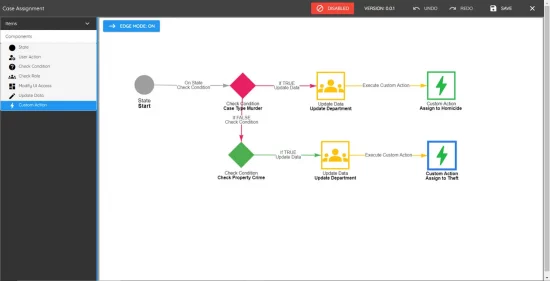Introduction to data analysis in law enforcement
Data analysis in law enforcement is an essential tool for identifying patterns, trends, and insights in criminal activities. It allows law enforcement agencies to make data-driven decisions, allocate resources effectively, and predict potential crime hotspots. By analyzing data such as crime rates, geographical locations, and demographic information, law enforcement can proactively address public safety concerns, enhance crime prevention efforts, and ultimately improve community policing strategies.

Importance of data analysis in crime prevention and solving
Data analysis is crucial in helping law enforcement agencies prevent and solve crimes effectively. By analyzing data, law enforcement can identify patterns, trends, and connections that may not be immediately apparent. This allows them to allocate resources more efficiently, anticipate and prevent criminal activities, and ultimately enhance public safety. Utilizing data analysis, law enforcement can better understand criminal behavior and develop proactive strategies to address it. Moreover, data analysis can also help in solving crimes by providing valuable insights and evidence that may lead to identifying suspects and bringing them to justice.
Types of data used in law enforcement
In law enforcement, various types of data are utilized to facilitate crime prevention and investigation. These include:
- Incident Data: Details about specific incidents, such as location, nature of the crime, and involved individuals.
- Criminal Records: Information about individuals’ criminal history, including arrests, convictions, and warrants.
- Surveillance Data: Data obtained from surveillance cameras, wiretaps, and other monitoring methods.
- Forensic Data: Evidence gathered from crime scenes, such as DNA, fingerprints, and ballistics.
Understanding and analyzing these types of data is crucial for law enforcement to make informed decisions and solve cases effectively.
Tools and techniques for data analysis in law enforcement
To efficiently analyze data in law enforcement, professionals often use various tools and techniques. Some common tools and techniques include:
- Statistical Analysis: This involves gathering, organizing, and interpreting numerical data to detect patterns and trends.
- Predictive Analytics: Utilizing historical data to forecast potential criminal activity and allocate resources proactively.
- Social Network Analysis: Examining connections between individuals to identify criminal networks and hierarchies.
- Geospatial Analysis: Mapping crime data to visualize patterns and hotspots within specific geographic areas.
By leveraging these tools and techniques, law enforcement can make informed decisions to enhance public safety and crime prevention strategies.
Success stories of data analysis in law enforcement
In San Diego, the police department was able to reduce property crimes by 33% by using data analysis to identify hotspots and target resources. They built predictive models to anticipate crime trends and deployed officers accordingly, leading to a significant drop in criminal activities in those areas. In New York City, the police department utilized data analysis to track crime patterns and identify repeat offenders, resulting in a 22% reduction in violent crimes. In both instances, the use of data analysis in law enforcement has proven to be instrumental in improving public safety and reducing criminal activity.
Challenges and limitations of data analysis in law enforcement
Data analysis in law enforcement is a powerful tool for solving crimes and identifying patterns. However, there are challenges and limitations to consider. Here are a few key points to keep in mind:
- Data accuracy and completeness are crucial for effective analysis
- Privacy and ethical concerns may arise when handling sensitive information
- Limited resources and expertise can hinder the implementation of data analysis tools in law enforcement
- Risks of bias and misinterpretation of data must be carefully managed
By being aware of these challenges, law enforcement agencies can better utilize the power of data analysis while addressing its limitations.
Ethical considerations in data analysis for law enforcement
When using data analysis in law enforcement, ethical considerations are crucial to ensure the protection of individual rights and privacy. Here are some key points to consider:
- Legal Compliance: Data analysis methods must adhere to existing laws and regulations to prevent any infringement of individuals’ rights.
- Transparency: It is essential to be transparent about the data collection and analysis processes to maintain trust and accountability.
- Bias and Discrimination: Guarding against biases in data analysis is crucial to ensure fair and equitable treatment of all individuals.
- Data Security: Protecting sensitive information and ensuring data security is vital to prevent unauthorized access or misuse of data.
- Accountability: Law enforcement agencies should be accountable for their use of data analysis, ensuring that it is used for legitimate and lawful purposes.
Considering these ethical considerations can help ensure that data analysis in law enforcement is used responsibly and ethically.
Future trends in data analysis for law enforcement
Law enforcement agencies are increasingly turning to data analysis to predict and prevent crimes. Predictive policing, which uses data to anticipate when and where crimes are likely to occur, is becoming more common. Additionally, predictive analytics can help police identify patterns and trends in criminal activity, leading to more effective crime prevention strategies. This data-driven approach is expected to continue growing in the law enforcement field, allowing agencies to make better-informed decisions and allocate resources more efficiently.
Training and education for law enforcement data analysis
Training and education play an essential role in preparing law enforcement professionals for data analysis. To effectively analyze data, officers need to receive specialized training in data collection, interpretation, and utilization. This includes learning how to use analytical software, understanding statistical methods, and interpreting complex data sets. Additionally, ongoing education is crucial to keep up with the latest trends and technologies in data analysis, ensuring that law enforcement officers can make informed decisions and act upon the insights gained from data.
Conclusion: The impact and potential of data analysis in law enforcement
Data analysis has the potential to significantly impact law enforcement by helping identify crime patterns and trends, aiding in resource allocation, and supporting predictive policing models. By leveraging data analysis, law enforcement agencies can improve their ability to prevent and solve crimes, ultimately enhancing public safety and community well-being. As technology continues to advance, the use of data analysis in law enforcement is likely to expand, providing even greater opportunities for crime reduction and improved policing strategies.




 520 838 0346
520 838 0346 sales@zinatt.com
sales@zinatt.com









